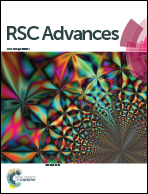Hydrogen adsorption in lithium decorated conjugated microporous polymers: a DFT investigation
Abstract
Two-dimensional carbon materials like graphene, porous graphene, covalent organic frameworks, graphyne and graphdiyne etc. decorated with light metals are found to be one of the prospective candidates as effective hydrogen storage materials. Here, we report an investigation of expanded porous two-dimensional models of the conjugated microporous polymers based on benzene, 1,3,5-triethynyl (CMP-1) and benzene, 1,3,5-tributadiyne (HCMP-1) decorated with lithium metal as efficient hydrogen adsorption materials. The modelled CMP-1 and HCMP-1 based networks are found to have band gaps of 3.5 and 4.0 eV respectively. These materials are found to hold lithium atoms above and below the C6 rings with a binding energy of around −44.9 kcal mol−1, which is more than the cohesive energy of lithium. Each lithium site is found to carry partial positive charge which can bind molecular hydrogen through ion-induced dipole interactions. The calculated adsorption energy per molecular hydrogen is found to be around −3.0 kcal mol−1 which is reasonably good. With three hydrogen molecules adsorbed per metal site, the CMP-1 network can adsorb hydrogen with a gravimetric density of 8.76 wt% and the corresponding density in HCMP-1 based material is found to be 7.06 wt% at 0 K.


 Please wait while we load your content...
Please wait while we load your content...